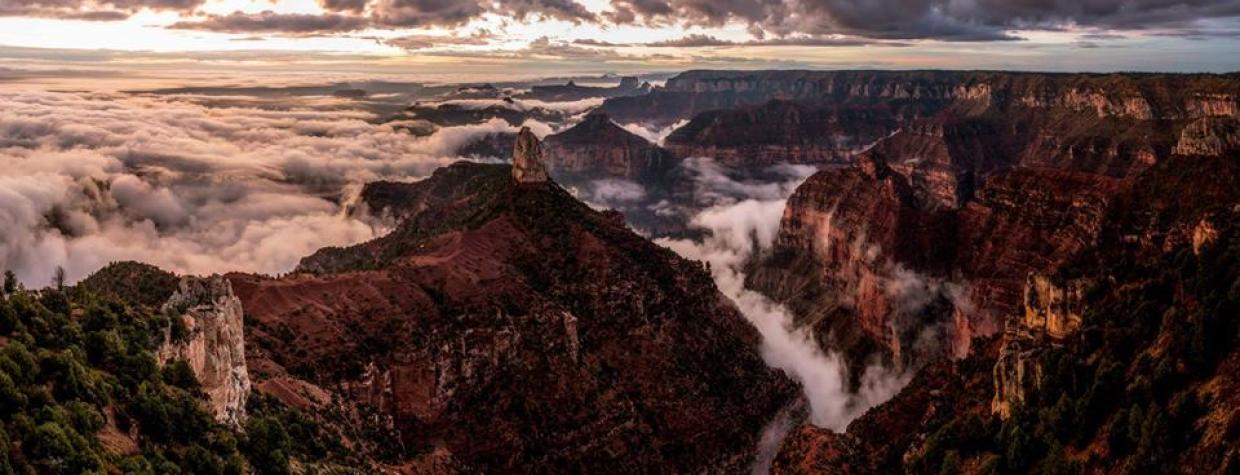A century and a half ago, John Wesley Powell led a pioneering expedition through the Grand Canyon via the Colorado River, paving the way for generations of future explorers. Powell extensively documented the journey, but one mystery remains: What happened to the three men who left the expedition and set off on foot into the wilderness, never to be seen again?
That question is at the center of Death on the North Rim, a new work of historical fiction written by Dewey Moore and published by Outskirts Press. To craft the novel's narrative, Moore combined historical facts about the Powell expedition with an imagined account of what happened to the three men. Via email, Moore talked with Arizona Highways about the inspiration for the book, his writing process and more.
Tell us about your background and how you got interested in historical fiction.
I was a geology professor at a small liberal arts school, Knox College, in Galesburg, Illinois. It was our custom to use spring break to take students to places where they could see natural examples of what we had touched upon in class during the term. On one of those trips, we rafted through part of the Grand Canyon and heard the story of John Wesley Powell’s group attempting to be the first to ever boat through the Grand Canyon. Only three days from the end of their trip, three crew members elected to leave the river trip rather than take on the largest, wildest rapids yet faced. Remains or evidence of these three have never been found. So, being fascinated by this, I began to investigate speculations about their fate and to imagine what might have happened.
Note that the trip to the Grand Canyon with students was in 1969 — 50 years ago. This story stuck in my mind until I couldn’t do much else than sit down and try to record it as a way to finalize having seen this beautiful landscape. Didn’t work. This landscape still holds me.
What compelled you to focus on George Bradley's story in particular?
There are plenty of stories about Powell, but little about his crew. For the 150th anniversary of the 1869 expedition, I thought the story might be a bit stronger if I made one of the crew more prominent — one who inconspicuously provided leadership.
You've done more technical or research-based writing in your career; how was the process different from your previous work?
All other of my writings are technical — lots of lab time, often conducted and reported with students. I co-authored one textbook — X-Ray Diffraction and the Identification and Analysis of Clay Minerals (Oxford University Press). This novel involved extensive archival research, camping in the story’s landscape, poring over U.S. Geological Survey reports and maps from about this time, and figuring out how to turn journal accounts into dialogue.
My wife, Shelley Roberts, was present from inception to the final period, sitting around a campfire with me in the real landscape of this story and prompting me to finish in time for Powell’s sesquicentennial celebration.
How much of Bradley's story, as portrayed here, is based in fact, and how much is imagined?
I offer at the end of the book a list of the works on which I relied the most — journals, letters, biographies, U.S. Geological Survey publications. My characters have different voices — ones I heard while working as a child in cannery fields, cutting asparagus. I developed a 17-page vernacular guide to keep their voices unique.
The trip through the Grand Canyon, the names of the crew members, the places they stopped each night, the landscape as best I could portray it, that three crew members very near to the end of the trip chose not to continue and apparently climbed out of the Canyon and were never heard from again — these are factual. After the group split, all is invented.
Bradley’s secret journals offered the most details about the actual expedition. Very little is known about his childhood, so I tried to create a background that showed how a person from a remote setting would have talents to contribute to making history. His U.S. Army career and Civil War injury are documented. Although Bradley only worked for Powell once, the major held him in high esteem. His two loves — fossils and Sophie — grew out of my imagination as a geologist.
Did you write the book to appeal to people who love the Grand Canyon? People who love historical fiction? Both?
Both. Although it wasn’t required, I reported to the college what we had done over spring break. As I tried to write a brief report, it got longer and longer, driven mostly by the dramatic landscape that we had just seen. My hope is that I’ve made Powell’s and Bradley’s journal entries come alive for people trying to imagine the raw courage it must have taken to map out that last blank spot on the U.S. map in 1869. I think it has been, and still is, a love and respect for the outdoors and the learning of what it all means — the "how" of what we see, that makes us see.
Where can people get the book?
The book can be ordered online at Amazon or Barnes and Noble. Treasure Chest Books is considering selling the book on the Grand Canyon's North Rim, and our marketing specialist is scouting concessionaire prospects on the South Rim.
— Noah Austin, Managing Editor

